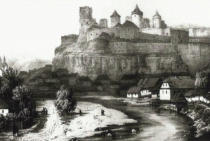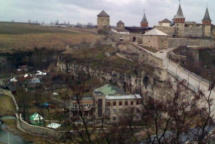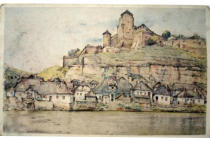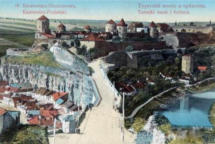
Compiled by Martin Davis © 2010- 2017
Click to enlarge photo

Origins of the Karvansary District
The Karvansary district derives its name from the original trading or Caravan destination that existed in the area below the Turkish castle from at least the late 1600’s. It was a main location, under the protection of the castle keepers, for both commerce and inns and was originally its own independent township - being outside the city walls of Kamenets. Some sources suggest that this was one of the first areas to be settled by Jewish people - although there is no doubt that Jewish residents had been living within the old town from at least the middle of the 1400’s. Undoubtedly, by the time of the Turkish conquest of the city, the area had become an area in which Jewish residents lived close to the old town of Kamenets and perhaps this had become a location for the refugees from the smaller towns that had originally sought protection ( see early history).A Centre of Kamenets Jewish Life
In the 18th century the Karvansary developed into a Jewish district and subsequently became a ghetto or confinement area for any Jews who were visiting the city and needed to remain overnight. As can be seen from the various depictions of the area, although the Karvansary was ‘picturesque’ it was on the flood plain of the river and at least in part at the mercy of the elements, especially during the time of the spring floods. To partially combat this the ground floors of the buildings were raised above ground level. In common with other aspects of Jewish life in Kamenets, there is little that is written about the actual day to day characteristics of life in the Karvansary. There was a synagogue or prayer hall located there - the existence of which is recorded from the second half of the 18th century. In the memoirs of Major Ptashynskoho, it was noted that in this synagogue the Jewish community Kamenets swore allegiance to the Russian Empress Catherine II [1].A Ghetto or a Refuge?
At times during attempted expulsions of Jewish people from the old town, the Karvansary became the home town of Jewish Kamenets, probably as it was for a considerable period an independent town and thus not actually under the direct control of Kamenets anti Jewish authorities. So it seems to have performed a duel function - at times a refuge and at times a ghetto. By 1923 the Karvansary had 150 households and 1566 residents. On 25 May 1923 by order of the Communist district executive committee Kamenets Karvansary was incorporated into the Kubachivskoyi Dovzhotskoho village area and in March 1926 the Karvansary finally and permanently lost its independence and became part of Kamenets - Podolsk (being simply designated as a street in the suburban area of the town). Today there is very little left of the old Karvansary township - a few houses and the central road seem to be all that remains of this once important and independent Jewish village.


[1] Podolskaya Starina (excerpts from the Journal of Major Ptashynskoho published in
the diocesan statements of Kamianets-Podilskyi).
Karvansary Through
Time
2010
c 1860
c 1910
c 1830



















